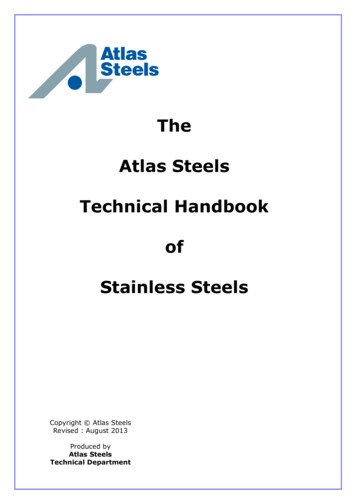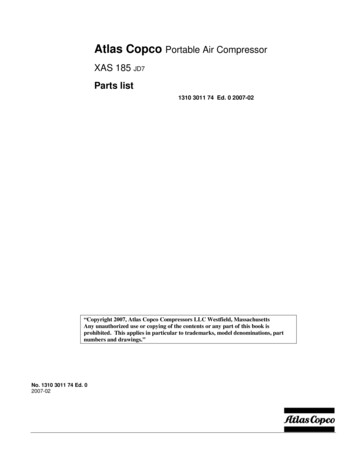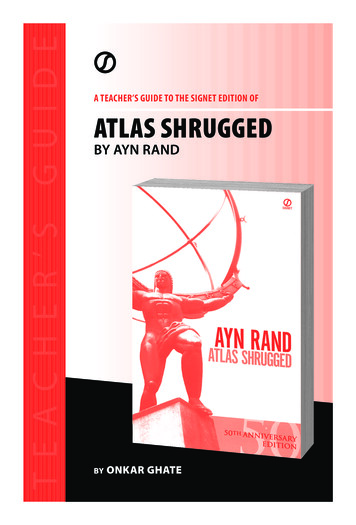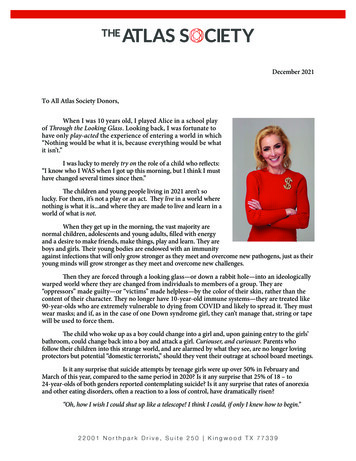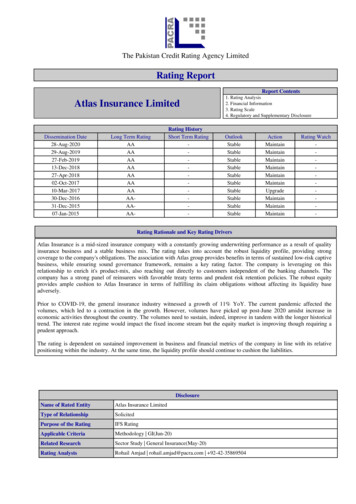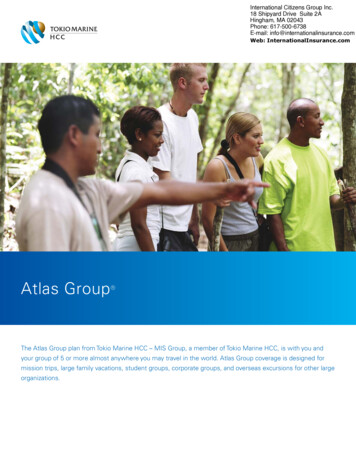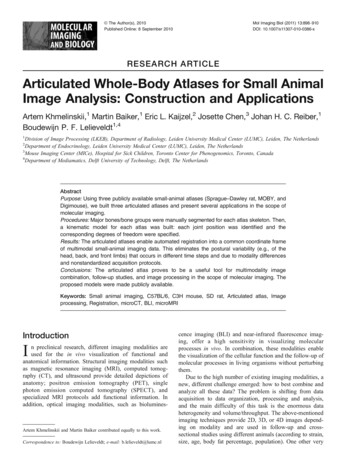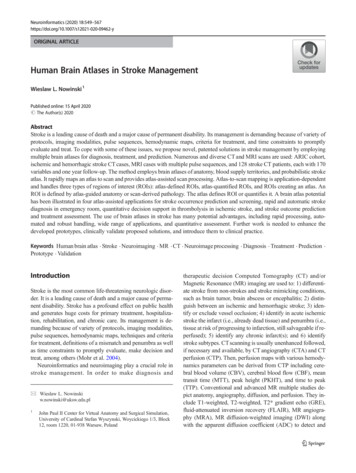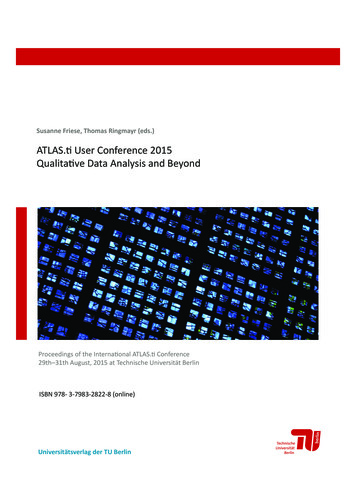
Transcription
Susanne Friese, Thomas Ringmayr (eds.)ATLAS.ti User Conference 2015Qualitative Data Analysis and BeyondProceedings of the International ATLAS.ti Conference29th–31th August, 2015 at Technische Universität BerlinISBN 978- 3-7983-2822-8 (online)Universitätsverlag der TU BerlinUmschlag ATLAS.ti 2015.indd 111.04.2016 14:00:33
Susanne Friese, Thomas Ringmayr (eds.)ATLAS.ti User Conference 2015Qualitative data analysis and beyondProceedingsAugust 29–31, 2015Technische Universität BerlinUniversitätsverlag der TU Berlin
Bibliographic information published by the Deutsche NationalbibliothekThe Deutsche Nationalbibliothek lists this publication in the Deutsche Nationalbibliografie;detailed bibliographic data are available in the Internet at http://dnb.dnb.de.Universitätsverlag der TU Berlin, 2016http:// verlag.tu-berlin.deFasanenstr. 88, 10623 BerlinTel.: 49 (0)30 314 76131 / Fax: -76133E-Mail: publikationen@ub.tu-berlin.deLicense: All contents of this publishing are licensedunder the following Creative-Commons-License agreement CC BY chlagfoto:Chrstian Stock 05743 CC BY 2.0 : Thomas RingmayrISBN 978-3-7983-2822-8 (online)Online published on the institutional Repository of the Technische Universität Berlin:DOI 9/depositonce-5079
Table of contents01 Friese, Susanne; McKether, Willie L.Qualitative social network analysis with ATLAS.ti: Increasing power in a ce-5152Anthropologists have a rich tradition of using a networked approach in data analysis. Thepurpose of this article is to continue that tradition by demonstrating how social networkanalysis can be used by anthropologists to improve their analysis and reporting ofethnographic data, and thereby expanding the methodological tool kit traditionally used byanthropologists. We use a case study based on a 1967 social movement aimed at increasingblack power in a small Midwestern community in the United States to demonstrate the utilityof network analysis in ethnographic studies and reporting, particularly ones that use oral orlife story narratives as primary data sources. In addition to examining the data throughMultinet, we also expand the Network View functionality in ATLAS.ti in our analysis. Wesuggest that the networked approach taken in this case study can be used byanthropologists across all four subfields as a method to show relations embedded in theethnographic data anthropologists are known for collecting.02 Wright, StevenExploring actor-network theory and CAQDAS: Provisional principles and practices forcoding, connecting and describing data using 3This paper explores how ideas from actor-network theory (ANT) can be drawn on to informways of using computer assisted qualitative data analysis software (CAQDAS) in an ANToriented project. Through this it explores some of the challenges ANT poses to conventionaluses of such tools, and the resources ANT provides for re-considering their agency inresearch practices and possibilities for future developments.CAQDAS is often associated with particular approaches to engaging with data (e.g., codingdata and retrieving the codes, abstracting and reducing data to themes etc.). Theseapproaches have become dominant enough such that they are often presented and/orinterpreted as the right, or only way to work qualitatively with qualitative data. In opposition tothis orthodoxy some orienting principles are proposed from the ANT literature along with itsintellectual antecedent ethnomethodology.The proposed principles are: freedom of movement and data, logging the inquiry usingLatour's four notebooks, coding and following heterogeneous actants as cases, supportingcontextual exploration of fluid and multiple ontologies, staying close to the words of theactants and working in a scale-free manner that enables shifting magnifications andassemblages to preserve detail rather than abstract it into themes. A final principle concernsthe intentions of ANT-informed approaches to assemble a detailed description, which arecontrasted with the intentions of approaches aligned with Grounded Theory to abstract datain order to construct an explanation.These principles are explored and illustrated with detailed descriptions that draw onexamples from a multi-modal ethnographic PhD research project. The project usedheterogeneous data to explore the information infrastructures and classification systemsused in craft beer judging. Examples of how that diverse dataset was coded and connectedare used along with excerpts from a reflective journal of the struggles and ideas for usingCAQDAS to illustrate ways of effectively using ATLAS.ti in ANT-oriented research projects.
03 Stähler, Tobias; Taylor, TrynitieDocuments and "their" actors: An empirical pathway for power-sensitive frameanalysis of political e-5154Framing has been termed a "fractured paradigm" by Robert Entman. Frames as media-textfeatures are prime examples of coding complexity since frames may be regarded as factualmedia content or a loose extracted collection of data snippets docking at a specific theme orevent. The potential of the concept for analyzing power relations within politicalcommunication is enormous and would benefit from further guiding information when workingwith CAQDAS. This paper seeks to provide an integral empirical perspective, and it includessuggestions for code families, coding rules, and query examples within ATLAS.ti.Furthermore, it discusses issues like frame types, frame setting, and frame sending.At its core, the paper joins text-based analysis with probing for the relevant actors' view viaguideline interviews. By doing so, it connects actor and process-oriented aspects of frameanalysis, following one prevailing approach on framing in communication science. It alsoadvises a flexible theoretical docking, but opts for a concise network perspective on actordocument relations. The result of the paper is not quite an empirical blueprint but a collectionof helpful yet optional procedures for frame analysis.04 Friese, SusanneComputer-assisted grounded theory analysis with 5In this paper I show how the various steps of a Grounded Theory analysis can be conductedin a computer-assisted environment. As the Grounded Theory approach was developedbefore the event of CAQDAS, the various steps and procedures have been described formanual ways of analysis. In newer books one finds references that this can of course also beaccomplished in CAQDAS, but little detail is provided on the practical aspects, as if theprocess were self-explanatory. Based on my experience, it is not, and this applies to theapplication of any methodological approach in CAQDAS. Learning the various tools andfeatures in a software does not automatically teach the user which tool is the best fit for aparticular process given a particular methodological framework. In this paper I want to showhow the various steps and procedures of the Strauss and Corbin approach to GroundedTheory can be translated for use in ATLAS.ti.05 Lewis, John KennedyUsing ATLAS.ti to facilitate data analysis for a systematic review of leadershipcompetencies in the completion of a doctoral -5156The author used ATLAS.ti to conduct a systematic review of the literature on leadershipcompetencies in fields undergoing rapid change to complete his dissertation. Studies wereimported to ATLAS.ti for first, second and third stage analysis which led to the creation offinal themes and concepts. The use of ATLAS.ti for coding encouraged a cyclical anditerative approach to data analysis that would have been difficult to accomplish through notecards, word processing, or spreadsheet applications. ATLAS.ti assisted with using metaethnography as the means of synthesizing both qualitative and quantitative research.ATLAS.ti provided the ability to make chains of multiple codes and linking of quotations tocreate networks, which was vital to third stage coding. These network diagrams werequalitative visual representations of the data and greatly assisted with third stage coding.Concepts, themes, and patterns emerged from the network diagrams. Also useful at thisstage for identifying patterns in the data was mapping of co-occurring codes. ATLAS.ti allowsco-occurring codes to be retrieved and visualized through network and mapping tools.Finally, ATLAS.ti was used to create hyperlinked maps of quotations which assisted with theanalysis of proposition three of this dissertation.
06 Zakaria, Rohaiza; Musta'amal, Aede Hatib; Amin, Nor Fadilah Mohd;Saleh, Halmi MashindraTranscribing with 7Most qualitative studies engage interviews and/or observations in their data collection phase,which comprise of audio and/or video data. These data are usually transcribed into a writtenform for further analysis. Since transcribing takes considerable amount of time, an efficienttool is required to prepare for the transcription. In fact, there are many software available inthe market to facilitate transcription including Inqscribe, Express Scribe and F4 Transkript.These transcription programs, however, were developed solely for transcribing purpose.ATLAS.ti, in addition to its superior tool set for the analysis of qualitative data, also can beused for transcription. In this paper, the authors emphasize the importance of thetranscription process in qualitative studies, and share their experiences in using ATLAS.ti fortranscribing audio and video data for a design study project.07 Kalpokaite, Neringa; Radivojevic, IvanaIntegrating ATLAS.ti into an undergraduate qualitative research course: evaluatingstudents' 5158This paper describes an evaluation of a qualitative research course for undergraduatepsychology students at IE University (Instituto de Empresa, Segovia, Spain) by analyzingstudents' perceptions and experiences as gathered through an open-ended questionnaire.Students studied qualitative methods, learned to use the computer-assisted qualitative dataanalysis software (CAQDAS) ATLAS.ti, and applied their knowledge in a case study researchproject on the leadership of an international company. Overall perceptions of the course arepositive, and students generally valued the learning and practical experience they gained.The students recognized this course as an important complement to their predominantlyquantitative curriculum. As a result, this paper encourages other interested lecturers andprofessors of undergraduate students to integrate CAQDAS into their own qualitativeresearch curricula.08 Apelojg, BenjaminTeachers do not make mistakes? Two explorative case studies ; relationships betweenbiographical aspects, thinking and behavioral patterns and experiences in classes ;first results of a qualitative study on the aspect of dealing with 9This article provides some insights into the complex relationships between thinking andbehavioral patterns, biographical aspects and teaching style. The data was analyzed in theGrounded Theory tradition and with the help of ATLAS.ti. The results presented here offerpreliminary findings only since the research is still ongoing. The focus is on the waysteachers deal with mistakes. Based on two case examples, it will be shown how the fear ofmaking mistakes can lead to teacher-centered lessons, and thereby limiting pupils'possibilities to learn autonomously.
09 Gutiérrez Espinosa, Enrique; Aguilar Gamboa, Hedaly; Castellanos León, Verónica C.;Carrillo González, Ileana del C.The use of ATLAS.ti in investigating bullying in primary schools in the city of TuxtlaGutiérrez, Based on an apparent increase of bullying cases among primary school students in the cityof Tuxtla Gutierrez, Chiapas, México, research was conducted to identify the characteristicsof the various forms of violence and abuse among children of this age group. The results ofthis research aided school authorities in implementing a prevention program that increasedstudent awareness of bullying and encouraged them to denounce it in hopes of reducing thisphenomenon. The subjects studied in the described research, were 117 fifth-grade boys andgirls between the ages of ten and eleven. Subjects were observed to identify the differentroles of this phenomenon such as bullies, victims, and bystanders, as well as the cause andeffects of their behavior. Additionally, focus group activities were conducted to measure thesubjects’ awareness of the bullying phenomenon and sensitize them to it. In this study, bothqualitative and quantitative methods were used to gather information about how the studentsexperience this kind of violence between themselves. The instruments used for thequalitative phase were surveys, focus groups and individual interviews, which were digitizedand analyzed using ATLAS.ti. The primary documents added to ATLAS.ti consisted oftranscripts, video recordings and the survey data as individual documents per case.10 Sebök, MiklósCoding policy influence with ATLAS.ti. Methodological notes from a study onhungarian The paper provides a cursory analysis of the methodological problems of coding policyinfluence in ATLAS.ti. In a series of notes on a research project on Hungarian banking, themeasuring problems of preference attainment are considered in the context of lobbying indeveloped democracies. Two such issues are discussed in more detail: The identification ofpolicy issues in large-sized corpora (as well as their relative importance), and the estimationof relevant policy positions regarding these important issues. For the first point, the flexiblecoding schemes as well as grouping and commenting features of ATLAS.ti contribute to aproper identification of policy issues and their respective boundaries. For the second point, itis asserted that the estimation of lobby group and government policy positions is bestassisted by the quotation managing, query and co-occurrence functions of the software. Thediscussion of this case study in applied qualitative data analysis also reveals the strongdependence of research results not only on appropriate research rules and procedures butalso the transparency thereof.
ATLAS.ti, in addition to its superior tool set for the analysis of qualitative data, also can be used for transcription. In this paper, the authors emphasize the importance of the transcription process in qualitative studies, and share their experiences in using ATLAS.ti for transcribing audio and video data for a design study project.
